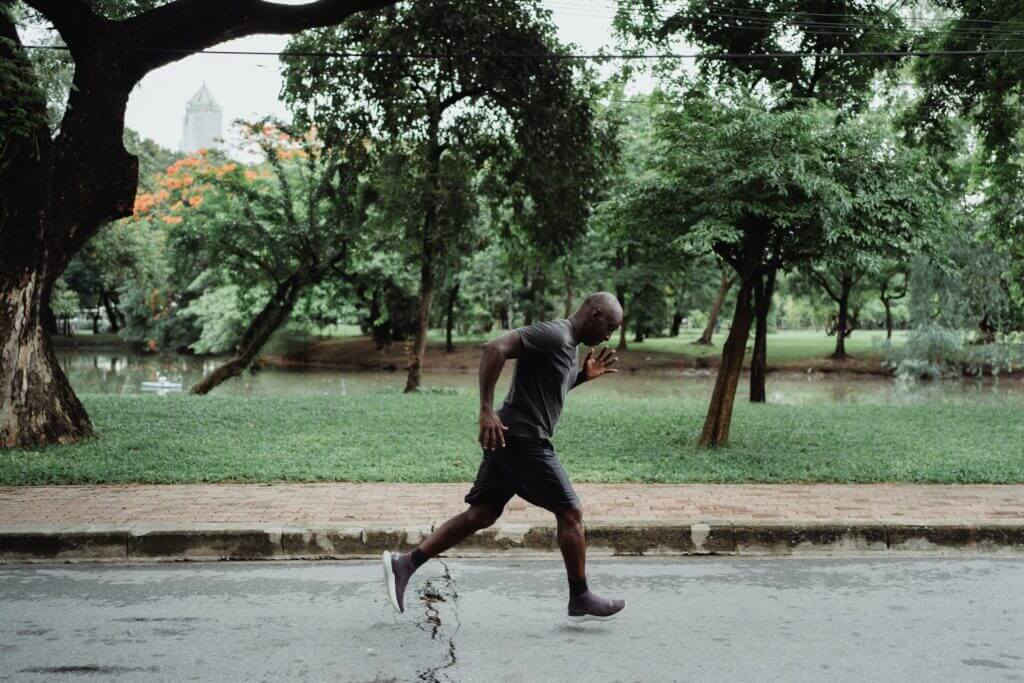Optimizing your stride length can have a significant impact on your running performance and reduce the risk of injury. Stride length refers to the distance covered by each stride while running, and it’s influenced by various factors such as leg length, flexibility, and running speed.
In this guide, we’ll explore the importance of stride length, how to measure it, and practical tips for improving it. We’ll also discuss the biomechanics of running and how optimizing stride length can improve efficiency. With the right stride length, you can cover more ground with each step, which means you’ll move faster and use less energy.
So, whether you’re a beginner or an experienced runner, understanding and optimizing your stride length can help you reach your full potential.
Table of Contents
What is Stride Length? Stride Length vs Step Length

Stride length and step length are two terms that are often used interchangeably when it comes to running, but they refer to two different measurements.
Stride length refers to the distance covered between two consecutive foot contacts of the same foot, while step length refers to the distance covered between two consecutive foot contacts of opposite feet. In other words, stride length is the distance covered by one leg while step length is the distance covered by both legs.
To understand the difference between stride length and step length, imagine taking a single step forward. The distance between your starting point and where your foot lands is your step length.
Now imagine taking two steps forward with your left foot, landing on your right foot in between each step. The distance covered between your starting point and where your left foot lands twice is your stride length.
Stride length is an important measurement when it comes to running because it is closely related to running speed. A longer stride length means that a runner can cover more ground with each step, leading to a faster overall pace.
However, taking overly long strides can lead to decreased efficiency, increased risk of injury, and decreased performance.
Step length, on the other hand, is more closely related to cadence or the number of steps taken per minute. A higher cadence with a shorter step length can help improve running efficiency and reduce the risk of injury, especially for long-distance runners.
Factors Affecting Stride Length
The average stride length of a runner is affected by a range of factors, both internal and external. Understanding these factors can help runners improve their form and performance, and prevent injuries. Here are some of the main factors that can impact the average stride length:
- Height and leg length
Your physical attributes, such as height and leg length, can have a significant impact on your stride length. Generally, taller runners and runners with longer legs tend to have a longer stride length than their shorter counterparts. This is because taller individuals have a greater distance to cover with each step, which naturally leads to a longer stride length.
- Flexibility
Flexibility is an important factor that can affect stride length. Tight muscles, particularly in the hips, hamstrings, and calves, can limit the range of motion in the joints and result in a shorter stride length. On the other hand, good flexibility can help increase stride length by allowing for greater joint mobility and a longer stride.
- Running speed
As your running speed increases, so does your stride length. This is because your body naturally adapts to the increased speed by taking longer strides. However, runners need to be careful not to take overly long strides, as this can lead to injuries and decreased performance.
- Terrain and running surface

The type of terrain and the running surface can also impact stride length. Running uphill or on a soft surface like sand or grass can reduce stride length, as the body needs to work harder to push off the ground with each step.
Conversely, running downhill or on a hard surface like a track can increase stride length, as the body is naturally propelled forward with each step.
- Running form
Proper running form is crucial for optimizing stride length. Poor form, such as over-striding or landing too heavily on the heel, can limit stride length and lead to injuries. A good running form involves landing lightly on the midfoot, keeping the torso upright, and swinging the arms in a controlled manner to help maintain balance and momentum.
- Shoes and equipment
The type of running shoes and equipment used can also impact stride length. Shoes that are too heavy, too cushioned, or too rigid can all affect stride length and running form. It’s important to choose shoes that are comfortable, well-fitted, and appropriate for your running style.
- Strength and power
Strength and power are important factors that can help increase stride length and running performance. Strong muscles in the legs and core can help improve running form, increase power output, and allow for a longer stride.
Incorporating strength training exercises, such as squats, lunges, and deadlifts, into your running routine can help improve muscle strength and power.
- Age and gender
Age and gender can also play a role in stride length. As we age, we tend to experience a decline in muscle mass, flexibility, and strength, which can all impact stride length. Women also tend to have a shorter stride length compared to men of the same height and leg length.
However, with proper training and exercise, it is possible to maintain and even improve stride length regardless of age or gender.
By understanding these factors, runners can work on improving their form and optimizing their stride length for their individual needs and goals. Incorporating stretching exercises, maintaining proper form, and choosing appropriate terrain and running surfaces can all help improve stride length and overall running performance.
How to Calculate Stride Length?
Calculating your stride length is an important aspect of monitoring your running form and progress. It’s a simple process that involves counting the number of steps you take over a known distance, but there are some tips and tricks to ensure accuracy. Here’s a step-by-step guide to help you calculate your stride length:
- Find a suitable location: Look for a flat and straight area to run on, such as a track, a long stretch of pavement, or even a treadmill. Avoid hills, curves, or rough terrain that can affect your stride length and make it challenging to count your steps accurately.
- Mark your starting line: You can use chalk or spray paint to mark your starting point, or simply use a visible landmark such as a tree or crack on the ground. This will help you maintain consistency when measuring your stride length.
- Run at your normal pace: Start running from your starting line and try to maintain your usual pace. Count the number of steps you take with your right foot over a distance of 50 meters (or roughly 165 feet). It’s important to count only the steps taken with one foot, so you may want to use a metronome or a running app that can help you stay on track.
- Calculate your total stride count: Once you have counted your steps, multiply the number by two to get your total stride count. For instance, if you counted 40 steps with your right foot, your total stride count would be 80.
- Measure the distance covered: You can use a measuring tape or a GPS device to measure the distance you covered in meters. Alternatively, you can use an online tool that can estimate the distance based on the time it took you to run. The distance should be at least 50 meters, but ideally longer to get a more accurate reading.
- Calculate your average stride length: Divide the distance covered by your total stride count to get your average stride length. For example, if you covered 100 meters and took 80 strides, your average stride length would be 1.25 meters.
Remember that your stride length may vary depending on a variety of factors such as speed, terrain, and fatigue. Therefore, it’s a good idea to measure your stride length at different speeds and under different conditions to get a more comprehensive view of your running form.
Additionally, using a stride sensor device that can be attached to your shoe or hip can be a great way to automatically measure your stride length and eliminate any potential human error.
Average Stride Length
When it comes to running, stride length is a crucial factor that can affect a runner’s speed, efficiency, and overall performance. While the average stride length can vary based on several factors, including height, leg length, and running speed, research shows that men tend to have longer strides than women.
According to a study published in the Journal of Sports Science & Medicine, the average stride length for adult men is around 2.5 feet or 30 inches (76 centimeters), while the average stride length for adult women is around 2.2 feet or 26 inches (66 centimeters). However, it’s important to note that these figures are just general averages and that individual stride lengths can vary widely depending on several factors.
Interestingly, stride length can also change depending on the pace of the run. When running at a faster pace, runners tend to take longer strides to cover more ground with each step. Conversely, when running at a slower pace, stride length tends to shorten as runners take more frequent, shorter steps to maintain balance and reduce the risk of injury.
Average Stride Length by Height
One way to estimate average stride length by height is by using the following formula:
- Step length = height in inches x 0.413 (for women) or 0.415 (for men)
- Stride length = 2 x step length
This formula is based on a study conducted by researchers at the University of Oklahoma, which found that multiplying height by 0.413 (for women) or 0.415 (for men) provided a good estimate of step length.
To use this formula, simply multiply your height in inches by the appropriate factor (0.413 for women or 0.415 for men) to get your step length. Then, multiply your step length by 2 to get your stride length.
For example, a woman who is 5 feet 6 inches tall (66 inches) would have a step length of approximately 27.258 inches (66 x 0.413) and a stride length of approximately 54.516 inches (2 x 27.258). A man who is 6 feet tall (72 inches) would have a step length of approximately 29.88 inches (72 x 0.415) and a stride length of approximately 59.76 inches (2 x 29.88).
To make it easier to visualize how stride length varies by height, here is a table showing estimated step length and stride length for men and women at heights from 5 feet to 6 feet 8 inches:
To make it easier to visualize how stride length varies by height, here is a table showing estimated step length and stride length for men and women at heights from 5 feet to 6 feet 8 inches.
| Height | Step Length (in) | Step Length (cm) | Stride Length (in) | Stride Length (cm) |
| 5’0” | 24.9 | 63.25 | 49.8 | 126.5 |
| 5’1” | 25.32 | 64.31 | 50.64 | 128.62 |
| 5’2” | 25.73 | 65.35 | 51.46 | 130.7 |
| 5’3” | 26.15 | 66.42 | 52.3 | 132.84 |
| 5’4” | 26.56 | 67.46 | 53.12 | 134.92 |
| 5’5” | 26.98 | 68.53 | 53.96 | 137.06 |
| 5’6” | 27.39 | 69.57 | 54.78 | 139.14 |
| 5’7” | 27.81 | 70.64 | 55.62 | 141.28 |
| 5’8” | 28.22 | 71.68 | 56.44 | 143.36 |
| 5’9” | 28.64 | 72.75 | 57.28 | 145.5 |
| 5’10” | 29.05 | 73.79 | 58.1 | 147.58 |
| 5’11” | 29.47 | 74.85 | 58.94 | 149.7 |
| 6’0” | 29.88 | 75.9 | 59.76 | 151.8 |
| 6’1” | 30.3 | 76.96 | 60.6 | 153.92 |
| 6’2” | 30.71 | 78 | 61.42 | 156 |
| 6’3” | 31.13 | 79.07 | 62.26 | 158.14 |
| 6’4” | 31.54 | 80.11 | 63.08 | 160.22 |
| 6’5” | 31.96 | 81.18 | 63.92 | 162.36 |
| 6’6” | 32.37 | 82.22 | 64.74 | 164.44 |
| 6’7” | 32.79 | 83.29 | 65.58 | 166.58 |
| 6’8” | 33.2 | 84.33 | 66.4 | 168.66 |
| Height | Step Length (in) | Step Length (cm) | Stride Length (in) | Stride Length (cm) |
| 5’0” | 24.78 | 62.94 | 49.56 | 125.88 |
| 5’1” | 25.19 | 63.98 | 50.38 | 127.96 |
| 5’2” | 25.61 | 65.05 | 51.22 | 130.1 |
| 5’3” | 26.02 | 66.09 | 52.04 | 132.18 |
| 5’4” | 26.43 | 67.13 | 52.86 | 134.26 |
| 5’5” | 26.85 | 68.2 | 53.7 | 136.4 |
| 5’6” | 27.26 | 69.24 | 54.52 | 138.48 |
| 5’7” | 27.67 | 70.28 | 55.34 | 140.56 |
| 5’8” | 28.08 | 71.32 | 56.16 | 142.64 |
| 5’9” | 28.5 | 72.39 | 57 | 144.78 |
| 5’10” | 28.91 | 73.43 | 57.82 | 146.86 |
| 5’11” | 29.32 | 74.47 | 58.64 | 148.94 |
| 6’0” | 29.74 | 75.54 | 59.48 | 151.08 |
| 6’1” | 30.15 | 76.58 | 60.3 | 153.16 |
| 6’2” | 30.56 | 77.62 | 61.12 | 155.24 |
| 6’3” | 30.98 | 78.69 | 61.96 | 157.38 |
| 6’4” | 31.39 | 79.73 | 62.78 | 159.46 |
Ideal Running Stride Length

The ideal stride length in running can vary based on several factors, including the runner’s height, leg length, and running speed. Generally, a longer stride length can help runners cover more ground with each step, leading to faster running times. However, a stride that is too long can also increase the risk of injury and decrease running efficiency.
To determine the ideal stride length for a runner, it’s important to consider their running biomechanics. The stride length should be long enough to generate forward momentum and minimize the time spent in contact with the ground, but not so long that it results in excessive braking forces or overstriding.
Overstriding occurs when a runner extends their leg too far in front of their body, which can cause the foot to land in front of the knee and increase the risk of injury.
One way to optimize stride length is to focus on increasing running cadence, or the number of steps taken per minute. Increasing cadence while maintaining the same running speed can lead to a shorter stride length, which can improve running efficiency and reduce the risk of injury.
There is no one-size-fits-all ideal stride length for runners, as it can vary based on individual differences in anatomy, running experience, and goals. However, coaches and trainers may use stride length norms and ratios to help athletes improve their running form and optimize their performance.
For example, a common guideline for optimal running form is a stride rate of 180 steps per minute, which equates to a stride length of approximately 1.5 times the runner’s height. However, this guideline may not apply to all runners and should be used as a starting point for further analysis and experimentation.
Overall, the ideal stride length for a runner optimizes their running efficiency and minimizes the risk of injury. This can vary based on individual differences in anatomy, running experience, and goals. Coaches and trainers may use stride length norms and ratios as a starting point for analyzing and improving running form, but runners need to experiment and seek professional guidance as needed.
The Role of Stride Length in Running

Stride length is an essential component of running biomechanics, which is the study of how the body moves during running. Understanding how stride length fits into the overall mechanics of running can help you optimize your form and reduce the risk of injury.
One of the key factors in running biomechanics is the relationship between stride length, cadence, and ground contact time. Cadence refers to the number of steps taken per minute, while ground contact time is the amount of time your foot spends on the ground with each stride.
Research has shown that there is an optimal range for both cadence and ground contact time that can help improve running efficiency and reduce the risk of injury.
Stride length plays a critical role in this relationship because it can impact both cadence and ground contact time. For example, if your stride length is too short, you may have to take more steps to cover the same distance, which can increase the amount of time your foot spends on the ground.
On the other hand, if your stride length is too long, you may spend more time in the air and less time on the ground, which can lead to inefficient running form and increased impact forces on your joints.
By optimizing your stride length, you can help ensure that your running mechanics are as efficient and safe as possible. This may involve working with a coach or physical therapist to assess your form and identify areas for improvement.
Additionally, exercises and drills that target stride length can help you strengthen the muscles and improve the flexibility needed for optimal running form.
How to Improve Stride Length?
Now that you understand the factors that affect stride length and how it impacts your running biomechanics, you may be wondering how to improve your stride length. Here are some tips and exercises that can help:
- Stretching
Tight muscles can limit your range of motion and reduce your stride length. Incorporate dynamic stretches that target your hip flexors, quads, hamstrings, and calves into your warm-up routine.
- Strength Training
Strengthening your core, glutes, and leg muscles can improve your running form and increase your power output. Exercises such as lunges, squats, deadlifts, and plyometrics can help build strength and explosiveness.
Drills that focus on proper posture, foot placement, and arm swing can improve your running economy and stride length. Examples of form drills include high knees, butt kicks, and bounding.
- Cadence Training
Increasing your running cadence (the number of steps per minute) can indirectly improve your stride length. Aim for a cadence of 170-180 steps per minute to maintain an efficient stride and reduce the risk of injury.
Hill Training: Running uphill forces you to take longer strides and recruit more muscle fibers. Incorporate hill repeats into your training to challenge yourself and build strength.
Remember, it’s important to gradually increase your training volume and intensity to avoid overuse injuries. Also, be patient with your progress – improving your stride length takes time and consistent effort. With practice and dedication, you can optimize your stride length and become a more efficient runner.
The Relationship Between Stride Length and Running Performance

Stride length is a key factor in running performance, as it can significantly impact both speed and endurance. When runners increase their stride length, they cover more ground with each step, which allows them to run faster without increasing their cadence. However, excessively long strides can lead to overstriding, which can cause a braking effect and lead to slower times.
In addition to speed, stride length can also affect running endurance. Longer strides require more energy and can lead to fatigue more quickly, while shorter strides may be more efficient over long distances. Finding the optimal stride length for a given distance requires a balance between speed and energy conservation.
One way to improve running performance through stride length is by focusing on cadence. By maintaining a consistent cadence and adjusting stride length accordingly, runners can find the most efficient and effective stride length for their goals. Another way is to incorporate stride length drills and exercises into training to improve strength, flexibility, and form.
Ultimately, the relationship between stride length and running performance is complex and depends on individual factors such as fitness level, running experience, and biomechanics. Experimenting with stride length during training runs and seeking professional guidance can help runners optimize their performance and achieve their running goals.
Conclusion
In conclusion, stride length is a crucial aspect of running that every runner should understand. Measuring your stride length accurately, and optimizing it through proper form, training, and exercise, can have a significant impact on your running efficiency, speed, and endurance.
Remember, everyone’s ideal stride length will vary based on their unique physiology and running goals, so it’s essential to experiment and find what works best for you. Whether you’re a beginner or an experienced runner, incorporating stride-length training into your running program can help you achieve your goals and reduce the risk of injury.
We hope this comprehensive guide has helped you better understand the concept of stride length and its importance in running biomechanics. Keep striding forward, and happy running!
You might like


